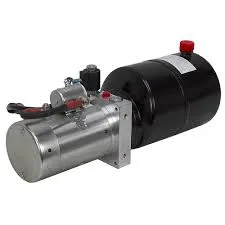Nov . 13, 2024 03:56 Back to list
double acting hydraulic cylinder products
Understanding Double Acting Hydraulic Cylinders Functionality, Applications, and Benefits
In the realm of hydraulic engineering, double acting hydraulic cylinders play a pivotal role in various industrial applications. These hydraulic devices are essential for converting hydraulic energy into mechanical work, making them an invaluable component in machinery and equipment. This article delves into what double acting hydraulic cylinders are, how they function, their applications, and the benefits they provide.
What is a Double Acting Hydraulic Cylinder?
A double acting hydraulic cylinder is a type of hydraulic actuator that can exert force in both extending and retracting strokes. Unlike single acting cylinders, which only use hydraulic pressure to extend and rely on a spring or external force for retraction, double acting cylinders utilize hydraulic pressure on both sides of the piston. This unique design allows for greater control and efficiency in a variety of applications.
How Does It Work?
The operation of a double acting hydraulic cylinder is relatively straightforward. At the core of the cylinder is a piston that separates the two chambers one for extending and one for retracting. When hydraulic fluid is pumped into the chamber behind the piston, the pressure builds up, pushing the piston out and extending the cylinder. Conversely, when fluid is directed to the chamber in front of the piston, it pushes the piston back, retracting the cylinder. This bidirectional action provides the cylinder with versatility and precise control over its movements.
Applications of Double Acting Hydraulic Cylinders
Double acting hydraulic cylinders are widely used in various industries due to their robustness and reliability. Some of the key applications include
1. Construction Equipment These cylinders are commonly found in excavators, bulldozers, and backhoes, where they control movements such as lifting, digging, and tilting.
2. Manufacturing Processes In assembly lines, double acting cylinders are used for tasks such as clamping, pressing, and moving heavy materials. They enhance productivity by enabling automated processes.
double acting hydraulic cylinder products

4. Automotive Industry In certain vehicle systems, hydraulic cylinders assist in actions such as braking and clutch operations, providing smooth and predictable control.
5. Material Handling Equipment such as forklifts and pallet jacks often employs double acting cylinders to aid in lifting loads safely and efficiently.
Benefits of Double Acting Hydraulic Cylinders
The use of double acting hydraulic cylinders offers numerous advantages
1. Increased Efficiency Because double acting cylinders can perform work in both directions, they reduce cycle times and overall energy consumption, leading to more efficient operations.
2. Greater Control Operators can achieve more precise movements with double acting cylinders due to the ability to control the speed and force of extension and retraction independently.
3. Enhanced Load Capacity These cylinders are designed to handle heavier loads, making them ideal for demanding tasks in construction and manufacturing.
4. Durability and Reliability Built from robust materials, double acting cylinders are engineered to withstand high pressure and harsh working conditions, ensuring long-term durability and reduced downtime.
5. Versatile Applications Their design lends them to a wide range of applications, making them suitable for almost any industry that requires reliable and effective mechanical motion.
Conclusion
Double acting hydraulic cylinders are fundamental components in numerous applications across various industries. Their ability to operate efficiently in both extension and retraction, coupled with their strength, reliability, and versatility, makes them an essential tool in modern engineering and machinery. Whether in construction, manufacturing, or agriculture, the importance of double acting cylinders cannot be understated, as they continue to enhance productivity and efficiency in numerous processes. Understanding their functionality and advantages can aid businesses in selecting the right hydraulic solutions for their operational needs.
-
Fork Lift Power Units - Hebei Shenghan | Efficiency, Reliability
NewsJul.13,2025
-
1.5-Ton Turbocharged Cylinder-Hebei Shenghan|Hydraulic Solution,Energy Efficiency
NewsJul.13,2025
-
Auto Hoist Power Units-Hebei Shenghan|Efficiency&Industrial Lifting
NewsJul.13,2025
-
Double Acting Power Units-Hebei Shenghan|Hydraulic Solutions,Industrial Efficiency
NewsJul.13,2025
-
1.5 Ton Lifting Cylinder 70/82-40-290-535 - High-Performance Hydraulic Solution | Hebei Shenghan
NewsJul.13,2025
-
Fork Lift Power Units - Hebei Shenghan | Efficiency&Reliability
NewsJul.13,2025
